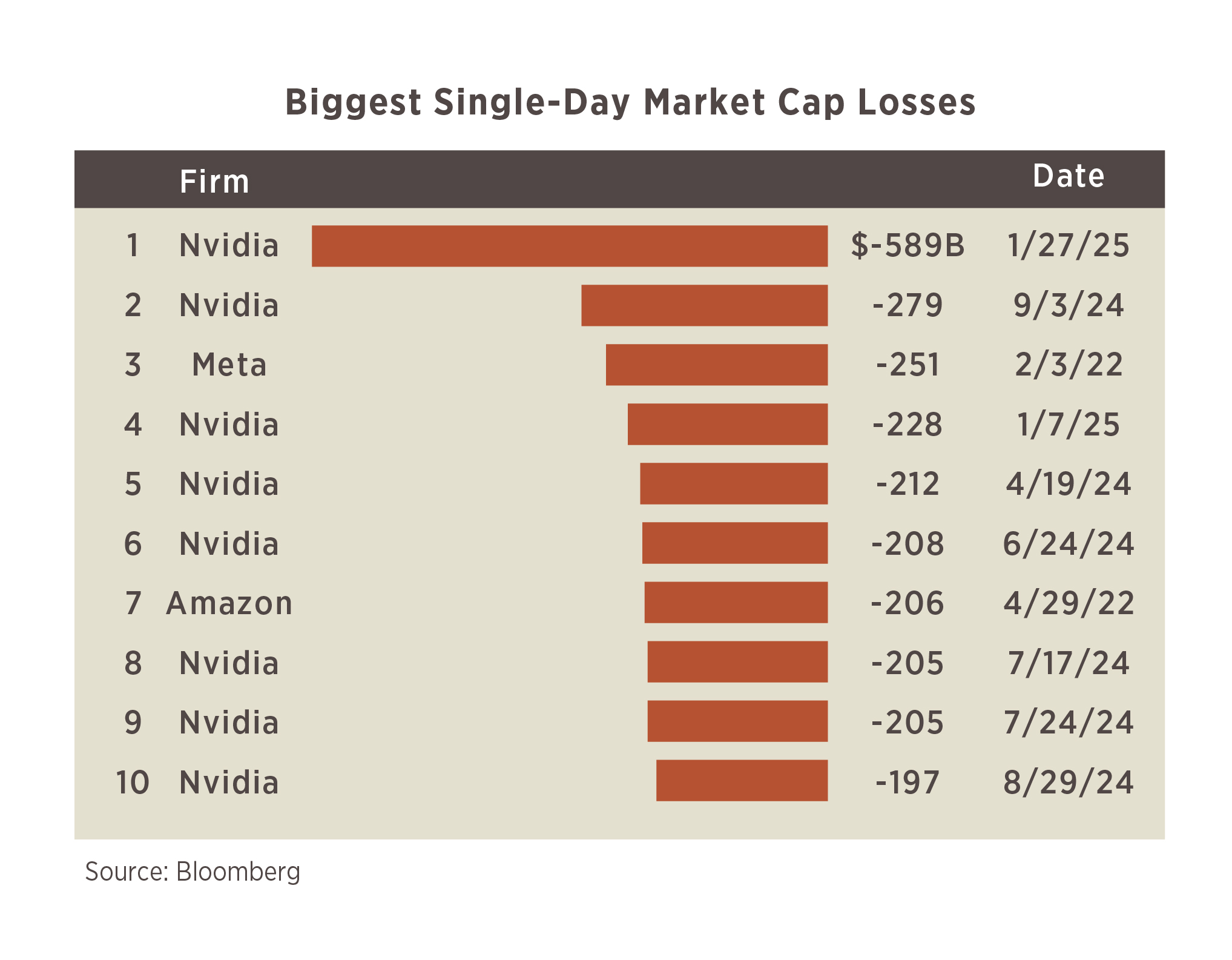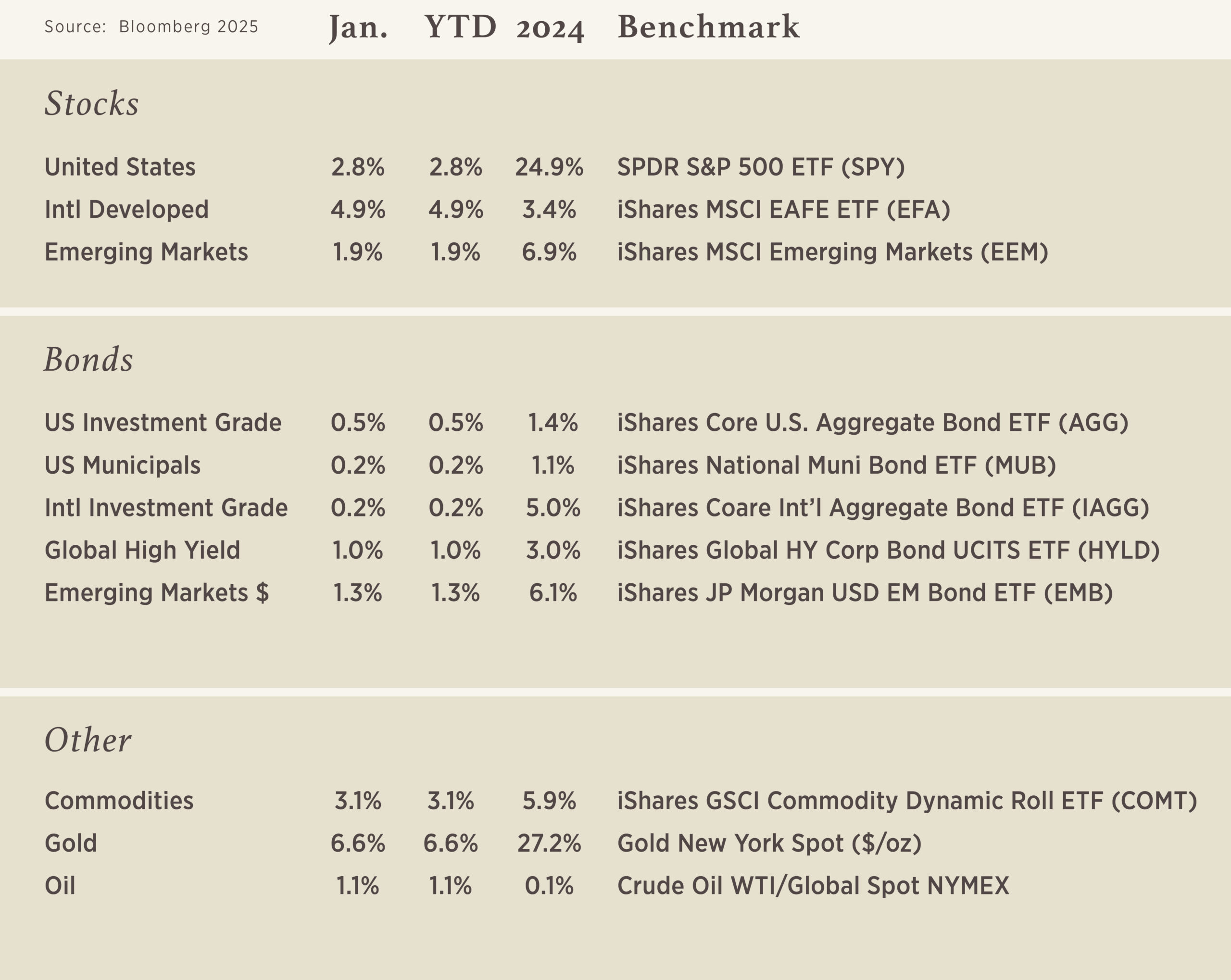Chart of the Month

IBM has Watson. Star Wars has R2-D2. Iron Man has J.A.R.V.I.S. All of these were of the Artificial Intelligence (AI) concept, which many are now becoming very familiar with by way of the last few years’ technological advancements like ChatGPT and the ensuing market performance of those companies most closely tied to the surging investments within the AI landscape.
The most prominent example when it comes to the market is Nvidia1, which in its most basic description, sells the powerful graphic processing units (GPUs) many deemed necessary to operate this AI technological advancement. It has become so prominent that it has found itself occasionally occupying the ‘largest company in the world’ moniker in the past few months when measured by market cap.
Since we wrote about the “BAATMMAN” stocks last month, it only seems appropriate to take a quote from Spiderman; “With great power comes great responsibility” when considering the size at which Nvidia1 has become!
This brings us to our chart of the month, illustrating the 10 largest single-day “market cap” losses. Now, most of these are fairly recent, which is not surprising given that a 5% decline today is far more impactful to market cap when the largest companies are worth $3 trillion today vs. $800 billion just 5 years ago.
But Nvidia1 holds 8 of the top 10 spots, the most recent coming on 1/27/2025 when it fell 17%, losing nearly $600B of value, more than many of the other largest companies in the world’s size are worth on their own (like Oracle, Exxon, and Costco). This drop was the result of a Chinese built AI model called DeepSeek1 that caught much of the market off-guard given what is stated to be very competitive performance at a significantly lower cost. Capitalism has a way of fostering competition.
While the headlines on January 27 mostly read “doom,” we found the day to be a great reminder on the powers of diversification. Yes, the S&P 500 was negative that day (-1.5%), but about 2/3 of the securities within it were positive. That is difficult to see in the headlines because of the weighting the largest companies hold within the S&P 500 Index, making their moves more impactful than those of smaller size. Remember the phrase from Spiderman!
1 Reinicke, Carmen. “Nvidia’s $589 Billion DeepSeek Rout is Largest in Market History.” Bloomberg.com, 27 Jan. 2025.


Strategies to Manage Rising Healthcare Costs
For many Americans, healthcare costs are a major source of worry as they prepare for retirement. Many retirees and pre-retirees may overlook medical care in retirement—costs that can increase every year. Many Americans believe that they can rely on Medicare; however, the reality is that Medicare only covers a percentage of health-related expenses, and most retirees pay large out-of-pocket healthcare expenses.
We believe it is critical to include healthcare in your long-term retirement strategy. Major medical expenses can change the course of your overall retirement; however, there are many strategies that may help you be better prepared. With our assistance, you can make preparations to help ensure that your medical needs are taken care of without adversely impacting your retirement lifestyle or becoming a financial burden on your family.
While there are many ways to address health care costs, and any solution you choose should be personalized to meet your needs, here are a few choices you may wish to consider:
Purchase Extended Care Insurance
Extended care insurance is designed to cover costs like extended hospital stays and skilled nursing. The major benefit of a well-thought-out extended care policy is that it can transfer the financial burden of care to the insurance company while being incorporated into your overall retirement strategy.
Extensive fine print on extended care policies can exclude benefits that you thought were due. For example, many policies contain exclusions for certain health conditions and may not cover all types of extended care services and facilities. Some purchasers of extended care insurance never need extended care, meaning that they end up paying years of premiums for little or no benefit. Extended care insurance can offer protection but it is critical to consult with a financial professional to choose the policy that best fits your current situation and expected future needs.
Set Up A Dedicated Investment Account Only For Extended Care Expenses
Investors with the means to do so can “self-insure” by setting aside a portion of their investment savings for medical expenses. The major benefit to this choice is that investors won’t be reliant on an insurance policy to cover expenses and will be able to use any remaining balance for other purposes. The obvious downside to this strategy is that all normal investment risks apply, and it is entirely possible that your investment savings may not be enough to cover all healthcare expenses.
Forecasting what your actual healthcare needs and medical costs may be is difficult. If you haven’t begun to plan for your future needs, it is time to start now. By beginning the process early, you can take advantage of lower premiums and may be able to forecast your retirement spending needs. Early preparation is especially important for those with existing illnesses or a family history of health problems. We believe that it is vital to have the advice of a financial professional who can look at your whole picture and help you choose an extended care strategy that’s right for your needs.
If you have any questions about how rising healthcare costs could affect your financial wellbeing, reach out to your financial advisor.





